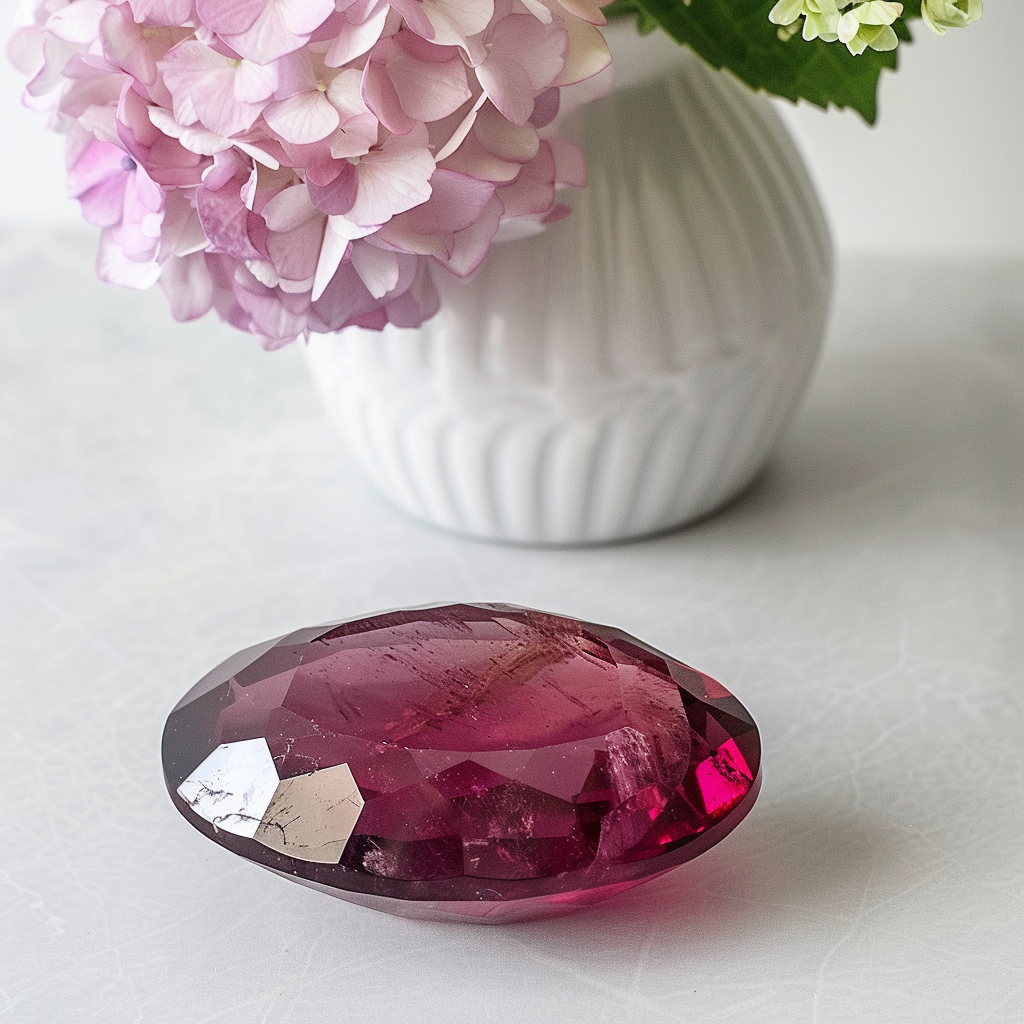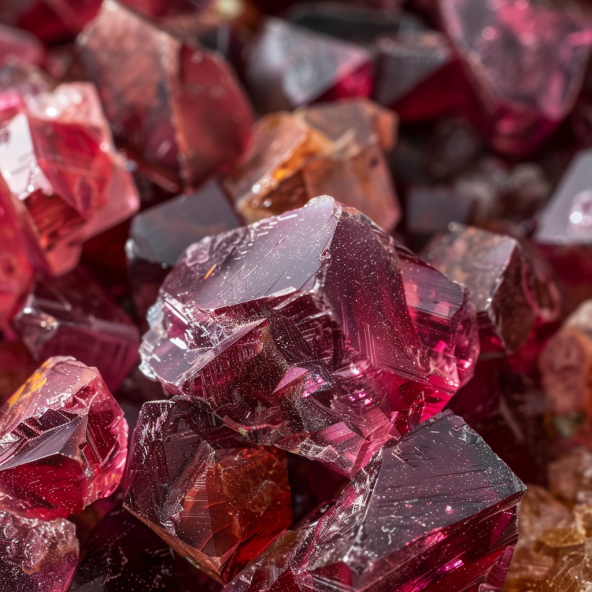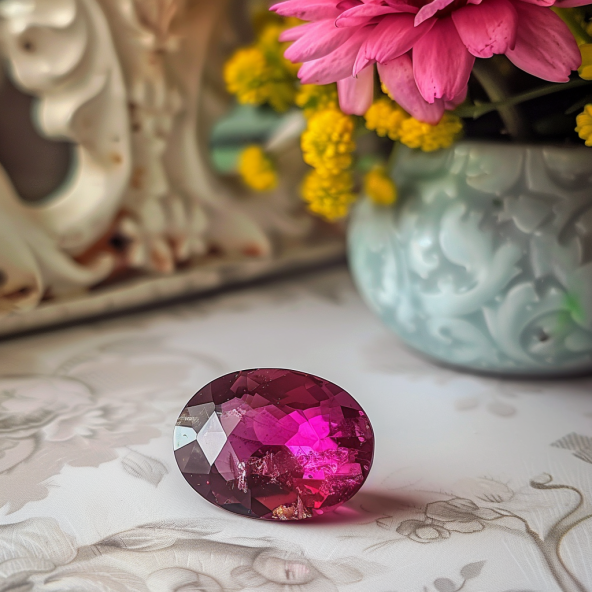Inclusions in Rhodolite Garnet
Rhodolite Garnet is a stunning gemstone known for its vibrant red and purple hues, often admired for its clarity and brilliance. However, like all gemstones, Rhodolite Garnet can contain natural imperfections known as inclusions. Understanding inclusions in Rhodolite Garnet is essential for anyone looking to purchase or evaluate this gemstone. In this blog, we will explore what inclusions are, how they affect the gemstone, and what to consider when selecting a Rhodolite Garnet with inclusions.

What Are Inclusions in Rhodolite Garnet?
Inclusions in Rhodolite Garnet are internal characteristics that form naturally during the gemstone’s creation process. These can include tiny crystals, fractures, or even fluid-filled cavities that are trapped within the stone. Inclusions are a common feature in many gemstones and are considered part of the natural beauty of the stone. In Rhodolite Garnet, inclusions can vary in size, type, and visibility, and they play a significant role in determining the gemstone’s overall quality and value.

Types of Inclusions in Rhodolite Garnet
There are several types of inclusions that can be found in Rhodolite Garnet, each with its own characteristics. Common types of inclusions in Rhodolite Garnet include:
- Needles: Thin, needle-like inclusions that can appear individually or in clusters. These are one of the more common inclusions in Rhodolite Garnet and can sometimes enhance the gem’s appearance by adding unique patterns.
- Crystals: Small mineral crystals that become trapped within the garnet during its formation. These can be visible to the naked eye or require magnification to be seen. Depending on their size and location, crystal inclusions in Rhodolite Garnet can either detract from or add to the gemstone’s character.
- Feathers: These are internal fractures that resemble feathers or wisps within the gemstone. Feathers are a type of inclusion that can impact the durability of Rhodolite Garnet, especially if they are large or reach the surface of the stone.
- Color Zoning: Although not a typical inclusion, color zoning occurs when different colors or shades appear within the same gemstone. Inclusions in Rhodolite Garnet can sometimes cause this effect, resulting in a unique and visually appealing gemstone.
How Do Inclusions Affect Rhodolite Garnet?
The impact of inclusions in Rhodolite Garnet depends on their size, type, and location within the gemstone. Generally, smaller and less visible inclusions have little effect on the stone’s appearance and value. However, large or prominent inclusions can reduce the gem’s brilliance and make it less desirable. Inclusions that affect the structural integrity of the gemstone, such as large feathers or fractures, can also lower its durability and should be considered carefully when selecting a Rhodolite Garnet.
K4615| play | medium| middle| “1.30 Ct. Rhodolite Garnet from Ceylon (Sri Lanka)”
Are Inclusions in Rhodolite Garnet Always a Bad Thing?
Inclusions in Rhodolite Garnet are not necessarily a bad thing. In fact, they can add to the gemstone’s uniqueness and natural beauty. Some collectors and enthusiasts appreciate inclusions for the character they bring to the gemstone. Additionally, inclusions can be a sign that the gemstone is natural and not synthetic, as synthetic stones often lack the inclusions found in natural gems.
Evaluating Inclusions When Buying Rhodolite Garnet
When purchasing a Rhodolite Garnet, it’s important to evaluate the inclusions to determine the gemstone’s quality. Using a loupe or magnification, you can inspect the stone for visible inclusions and assess their impact on the gem’s appearance. High-quality Rhodolite Garnets typically have minimal or well-placed inclusions that do not detract from the stone’s beauty. If inclusions are present, consider how they affect the gem’s overall look and whether they add character or diminish its appeal.
Caring for Rhodolite Garnet with Inclusions
Rhodolite Garnet with inclusions requires careful handling to ensure its longevity. Inclusions, especially those that reach the surface, can make the gemstone more susceptible to damage. To protect your Rhodolite Garnet, avoid exposing it to harsh chemicals, extreme temperatures, or direct impact. Regular cleaning with warm soapy water and a soft brush will help maintain its appearance without compromising the gemstone’s integrity.

Inclusions in Rhodolite Garnet are a natural part of the gemstone’s formation and can vary widely in appearance and impact. Understanding these inclusions is key to selecting a high-quality Rhodolite Garnet that meets your aesthetic preferences and needs. Whether you view inclusions as a unique feature or a factor to be minimized, they play a significant role in the overall character and value of Rhodolite Garnet.
Learn what makes Rhodolite Garnet both beautiful and enduring in our guide to the Durability and Hardness of Rhodolite Garnet.
